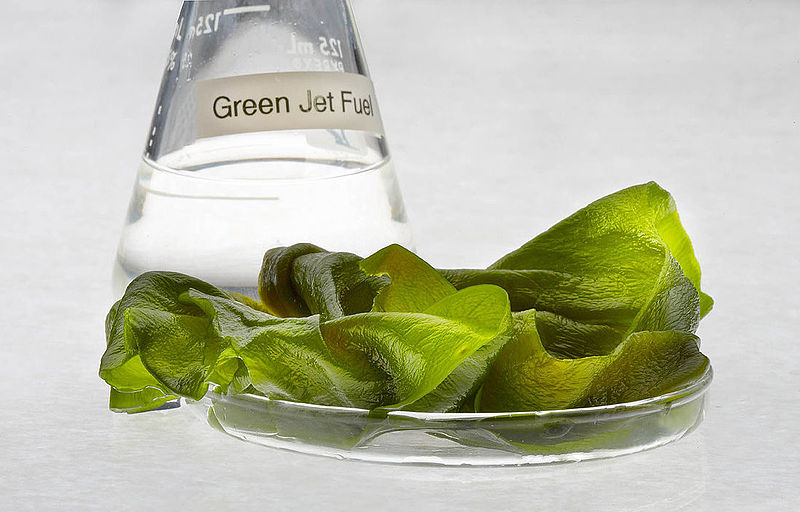Author:
Biodiesel
The U.S. Department of Energy’s Aquatic Species Program, 1978–1996, focused on biodiesel from microalgae. The final report suggested that biodiesel could be the only viable method by which to produce enough fuel to replace current world diesel usage.
If algae-derived biodiesel were to replace the annual global production of 1.1bn tons of conventional diesel then a land mass of 57.3 million hectares would be required, which would be highly favorable compared to other biofuels.
As they do not have to produce structural compounds such as cellulose for leaves, stems, or roots, and because they can be grown floating in a rich nutritional medium, microalgae can have faster growth rates than terrestrial crops.
Also, they can convert a much higher fraction of their biomass to oil than conventional crops, e.g. 60% versus 2-3% for soybeans. The per unit area yield of oil from algae is estimated to be from between 4,700 to 18,000 m3/km2/year (1,000 to 6,500 US gallons/acre/year). This is 7 to 30 times greater than the next best crop, Chinese tallow (650 m3/km2/year, or 700 US gal/acre/year).[dubious – discuss]
Studies show that some species of algae can produce up to 60% of their dry weight in the form of oil. Because the cells grow in aqueous suspension, where they have more efficient access to water, CO2 and dissolved nutrients, microalgae are capable of producing large amounts of biomass and usable oil in either high rate algal ponds or photobioreactors.
This oil can then be turned into biodiesel which could be sold for use in automobiles. Regional production of microalgae and processing into biofuels will provide economic benefits to rural communities
Biofuel Alternative
 The growing global demand for energy has caused a steep rise in energy prices, notably for petroleum-based fuels which are the prime source of energy for most of the world’s power plants, machinery, and transportation. As more and more so-called “fossil fuels” are burned to create energy, there has also been a steep rise in the emission of polluting gases around the world. Personal automobiles are the main culprit, since they produce most of the carbon dioxide (CO2) released daily into the atmosphere. CO2 is considered a “greenhouse gas,” trapping heat from the sun at the surface of the earth much the way a greenhouse traps heat inside its glass walls.
The growing global demand for energy has caused a steep rise in energy prices, notably for petroleum-based fuels which are the prime source of energy for most of the world’s power plants, machinery, and transportation. As more and more so-called “fossil fuels” are burned to create energy, there has also been a steep rise in the emission of polluting gases around the world. Personal automobiles are the main culprit, since they produce most of the carbon dioxide (CO2) released daily into the atmosphere. CO2 is considered a “greenhouse gas,” trapping heat from the sun at the surface of the earth much the way a greenhouse traps heat inside its glass walls.
Biofuels are by definition any fuel that, by being burned, can be converted to energy, and that is produced from a biological source. Since a biological source is also a renewable one, biofuels are reproducible. Unlike fossil fuels of which there is a fixed amount on earth, biofuels can continue to be produced so long as a source of biomass is available. The types of raw material that be converted into biofuel include organic plants, animals (especially animal fat), and even animal and human waste material.
One type of fuel already being produced from biological sources is biodiesel. This fuel, which burns cleaner than its petroleum-based cousin, can be used by most diesel engines without any need for conversion. Many companies are already involved in the production and distribution of a form of biodiesel known as B20. B20 is a mixture of petroleum-based diesel and biofuel “diesel equivalent.”
Biofuel is already being made from corn and soy, for example. But using corn and soy has correspondingly driven up the demand for both foods, which while being ideal for biofuel production, are also consumed as food by people around the globe. Using these foods for biofuel has pushed up their cost considerably, which in turn has created food shortages in some areas of the world. This has produced an unexpected quandary for biofuel proponents.
If biofuel is ever to become a true alternative to fossil fuels, a way is needed out of this quandary. One possibility is the use of algae as a biofuel foodstock. Algae have the advantage of being a non-food source which can be produced in areas not already being used to grow other types of food. Corn, soy and cottonseed must be grown on arable land. Algae can be grown in pools, in warm climates around the world, and acre per acre algae yield over a hundred times the quantity of biomass of soybeans.
Since algae take in, rather than produce, carbon dioxide, the very foodstock being used to create biofuel can itself be a cause for a reduction in a significant greenhouse gas. Algae biofuel farms could therefore benefit from a dual income stream. The first is from the sale of the algae itself to refineries for the production of biofuel. The second is income generated from the use of the algae farm as a consumer of other forms of pollution.
Some companies have recognized the benefit to poorer communities of developing the market for biofuels while at the same time encouraging the development of foodstock supplies such as algae farms. These companies are planning to encourage production of foodstock for biofuel in poorer countries to supply the energy needs of more developed areas of the world should raise everyone’s quality of life, both in economic terms and in terms of encouraging a cleaner global environment.
Algae Biofuel
 Algae fuel or Algal biofuel is an alternative to fossil fuel that uses algae as its source of natural deposits. Several companies and government agencies are funding efforts to reduce capital and operating costs and make algae fuel production commercially viable. Harvested algae, like fossil fuel, release CO2 when burnt but unlike fossil fuel the CO2 is taken out of the atmosphere by the growing of algae and other biofuel sources, and the world food crisis, have ignited interest in algaculture (farming algae) for making vegetable oil, biodiesel, bioethanol, biogasoline, biomethanol, biobutanol and other biofuels, using land that is not suitable for agriculture. Among algal fuels’ attractive characteristics: they can be grown with minimal impact on fresh water resources, can be produced using ocean and wastewater, and are biodegradable and relatively harmless to the environment if spilled. Algae cost more per unit mass (as of 2010, food grade algae costs ~$5000/tonne), due to high capital and operating costs, yet are claimed to yield between 10 and 100 times more fuel per unit area than other second-generation biofuel crops. The United States Department of Energy estimates that if algae fuel replaced all the petroleum fuel in the United States, it would require 15,000 square miles (39,000 km2) which is only 0.42% of the U.S. map, or about half of the land area of Maine. This is less than 1⁄7 the area of corn harvested in the United States in 2000. However, these claims remain unrealized commercially. According to the head of the Algal Biomass Organization algae fuel can reach price parity with oil in 2018 if granted production tax credits. But in 2013, Exxon Mobil Chairman and CEO Rex Tillerson said that after spending $600 million on development in a joint venture with J. Craig Venter’s Synthetic Genomics since 2009, algae fuel is “probably further” than 25 years away from commercial viability. On the other hand Algenol claim to have already produced 9,000 gallons per acre of ethanol and hope to produce commercially in 2014.
Algae fuel or Algal biofuel is an alternative to fossil fuel that uses algae as its source of natural deposits. Several companies and government agencies are funding efforts to reduce capital and operating costs and make algae fuel production commercially viable. Harvested algae, like fossil fuel, release CO2 when burnt but unlike fossil fuel the CO2 is taken out of the atmosphere by the growing of algae and other biofuel sources, and the world food crisis, have ignited interest in algaculture (farming algae) for making vegetable oil, biodiesel, bioethanol, biogasoline, biomethanol, biobutanol and other biofuels, using land that is not suitable for agriculture. Among algal fuels’ attractive characteristics: they can be grown with minimal impact on fresh water resources, can be produced using ocean and wastewater, and are biodegradable and relatively harmless to the environment if spilled. Algae cost more per unit mass (as of 2010, food grade algae costs ~$5000/tonne), due to high capital and operating costs, yet are claimed to yield between 10 and 100 times more fuel per unit area than other second-generation biofuel crops. The United States Department of Energy estimates that if algae fuel replaced all the petroleum fuel in the United States, it would require 15,000 square miles (39,000 km2) which is only 0.42% of the U.S. map, or about half of the land area of Maine. This is less than 1⁄7 the area of corn harvested in the United States in 2000. However, these claims remain unrealized commercially. According to the head of the Algal Biomass Organization algae fuel can reach price parity with oil in 2018 if granted production tax credits. But in 2013, Exxon Mobil Chairman and CEO Rex Tillerson said that after spending $600 million on development in a joint venture with J. Craig Venter’s Synthetic Genomics since 2009, algae fuel is “probably further” than 25 years away from commercial viability. On the other hand Algenol claim to have already produced 9,000 gallons per acre of ethanol and hope to produce commercially in 2014.
